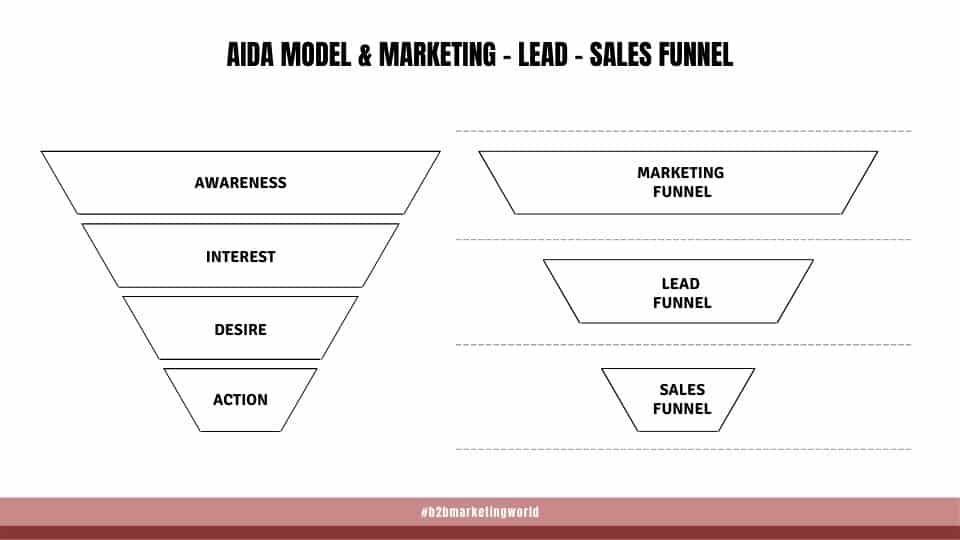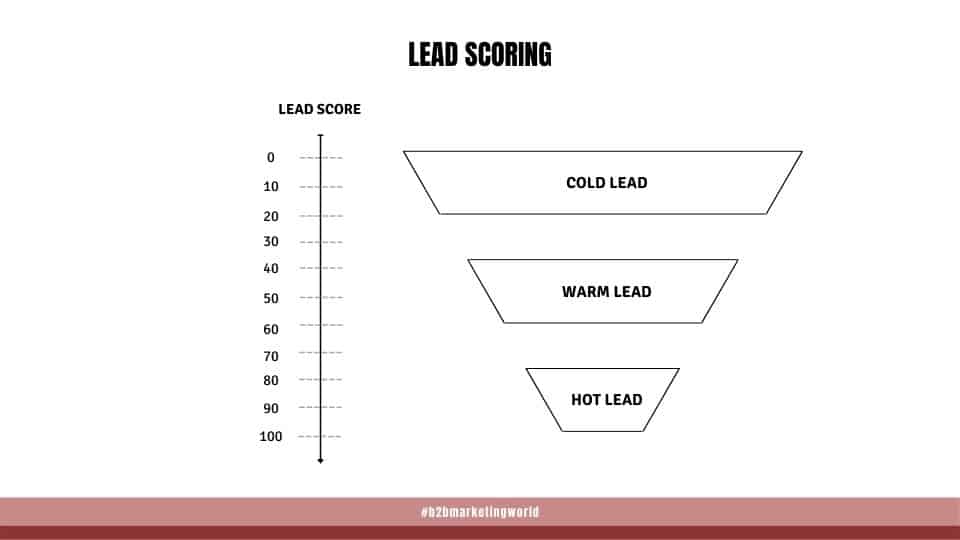What is Lead Management?
A definition of Lead Generation, Lead Nurturing and Lead Qualification
You need a simple defintion of Lead Management? The definition varies in literature. This is not surprising because the definition depends on the responsibility for lead management. The task to generate, nurture and qualify leads may lie with sales or with marketing. That’s why the definition varies from a sales centric perspective to a more marketing focused one. The broadest possible definition is: Lead Management consists of all processes and actions to win potential customers and convert them to customers. This is also the goal of Lead Management: create new sales opportunities.

3 Article Highlights
Table of Contents
Table of Contents
Newsletter
Subscribe and Learn B2B Marketing.
Lead Management Definition
To understand the definition of Lead Management and its core value, look at the bigger picture. Lead Management is the interface between marketing and sales. The process to generate leads is the middle part of the marketing and sales funnel. Based on the basic “AIDA” model, the funnel can be described:
That means that the lead funnel needs to convert interest into desire. And, the lead funnel bases on the marketing funnel and leads to the sales funnel. Therefore, it’s a very interesting link between two typically separated departments. The implication of this perspective is that Lead Management has the potential to align marketing and sales.
Having these aspects in mind, the best definition is:
Lead management is defined as the methodology, process and software to generate, nurture and qualify leads using sales and marketing strategies.
This definition not only covers the lead funnel but also outlines the three core functions of lead management:
- Lead Generation
- Lead Nurturing
- Lead Qualification
Lead Generation
Based on the marketing-lead-sales funnel, the first job of Lead Management is to generate leads. This is done by converting potential but largely unknown customers into someone interested in the company and products or services. It, therefore, includes all measures necessary to create a cold lead. Further, lead generation also marks the interface between the marketing funnel and the lead funnel. These four steps along the lead generation process are closely linked to marketing actions. Especially the first step has no clear separation to marketing and is typically shared between the two disciplines.
1. First touchpoint with the company
Simple. The unknown member of your target group needs to engage with your content. A, often digital, first touchpoint is the start of the customer journey. This initial contact with your company expresses first interest and is an essential part of lead creation.
2. Engagement with content
The more engagement, the better. Online examples are clicks, sessions-duration or other engagement metrics. Offline, the person expresses interest at an exhibition or simply calls you.
3. Call-to-Action (CTA)
The click on a CTA marks an interesting moment in this fresh relationship. It’s something like the first kiss with your date. It’s an expression of interest and the willingness to further engage with you and your company. CTAs vary from downloads, contact forms to live chats or e-mail subscriptions.
4. Share additional contact details
Ideally, the members of your target group will share contact details such as name, e-mail, company, job title and alike. The tricky aspect of this step is to ask as much data to work with the prospect. Another difficulty is keeping the barrier low. Examples vary from e-mail only registrations to full-scale contact forms that ask for your social security number.
The result of the lead generation phase is a new lead, defined by criteria by the marketing and the lead management department.
Lead Nurturing
Lead nurturing, also called lead cultivation or lead development, is turning a cold lead into a hot lead by continuing interaction with the prospect. Regarding the AIDA model, this means to turn an interest into a desire. Lead scoring helps to identify how far the lead is developed.
To increase the lead score, it is necessary to nurture the lead via targeted marketing activities. A common approach is to define lead nurturing campaigns that target already known customers. Different marketing actions and content are used to further engage and develop a lead depending on the lead score. How many points a lead is assigned for a certain engagement (e.g. download; contact form or sign-up) depends on your company and how valuable you think this very touchpoint is.
Ultimately a hot lead handed over from marketing to sales is called a marketing qualified lead (MQL). A MQL is a typical output and performance KPI of the marketing department.
Lead Qualification
The third and last step of lead management is to qualify leads. As already described, a cold lead is nurtured to become a hot lead. The transition from lead scoring to lead qualification – a MQL – is also the first qualification step. The two other common steps are a Sales Accepted Lead (SAL) and a Sales Qualified Lead (SQL).
A MQL is qualified by the marketing team, based on defined criteria. However, the sales team needs to cross-check if the MQL really fulfills all defined criteria. This is a sort of double check on the lead quality. If sales accept the MQL, the lead status changes to SAL, and the lead is assigned to a sales representative.
At this point, either the sales representative or the sales back-office reaches out to the customer to align on his request and clarify his demand. The end of this process marks the last step in the lead qualification. If successful, the SAL becomes a Sales Qualified Lead and the sales funnel is in full swing.
Crucial aspects for a good Marketing – Lead – Sales Process
The output of the lead funnel – a sales accepted lead – also is a critical task for the sales funnel. If lead management is poor, the sales funnel might remain empty. Or, even worse, sales is flooded with spammy leads. Therefore, these two critical aspects need to be considered:
- Sales needs to trust Lead Management
Without mutual trust and alignment, the qualification process is bound to fail. The sales department can reject a MQL and hence, influences the target value of the lead management department. The feedback loop between sales and lead management is critical, as lead management needs to learn if, e.g. the qualification process is faulty. Therefore, open discussions, regular meetings and mutual trust are of the highest value.
- Sales must not be spammed by Lead Management
There is a risk that marketing aims to create as many MQLs as possible to reason their marketing spending. There, the output of the lead funnel spams and blocks the sales funnel. Sales reps are tied up in trying to find high quality leads that convert. A KPI to measure this aspect is the ratio of MQLs and SALs. This quality ratio should be close to 1. The higher the ratio is, the closer lead management brings a lead to the expectations of sales. The lower the ratio is, the more spam leads management creates.
Summary
The definition of lead management varies in literature because the definition depends on the responsibility for lead management. The task to generate, nurture and qualify leads may lie with sales or with marketing. For a proper definition, look at the bigger picture. Lead Management is the interface between marketing and sales. Having these aspects in mind, the best possible definition is
Lead management is defined as the methodology, process and software to generate, nurture and qualify leads using sales and marketing strategies.
This definition also outlines the three core functions of lead management:
- Lead Generation
- Lead Nurturing
- Lead Qualification
The first step of Lead Management is to generate leads by converting potential customers into someone who has shown interest. The result of the lead generation phase is a new lead. A lead is a mutual definition of the marketing and the lead management department.
Lead nurturing, also called lead cultivation or lead development, is the process of turning a cold lead into a hot lead. This is done by continuing interaction with the prospect and increase the lead score. The higher the score is, the hotter the lead gets. Ultimately this lead is handed over from marketing to sales. This is called a marketing qualified lead (MQL).
The last step of lead management is to qualify leads. The typical qualification as MQL to a Sales Accepted Lead (SAL) is followed by the ultimate step – the Sales Qualified Lead (SQL). This final step marks the end of the lead funnel, and the sales process starts.
Stephan Wenger
B2B Marketing Expert, Editor and Marketing Management Consultant
Stephan Wenger is a seasoned B2B Marketing Expert with more than 10 years of experience in leading global companies. His extensive expertise lies in the realms of B2B online marketing, content marketing, strategic marketing, and driving synergy between sales and marketing, including effective lead management.
You May Like the Following Articles
B2B Sales
Business-to-business sales (B2B Sales) refers to companies and sales teams selling to other companies. Companies must establish touchpoints throughout the buying process to ensure consistent engagement with potential buyers at every stage. This requires both the marketing team and sales reps to work together. In this blog post, we will show what B2B sales is, what it means, and how it works and give you real-life sales examples.








